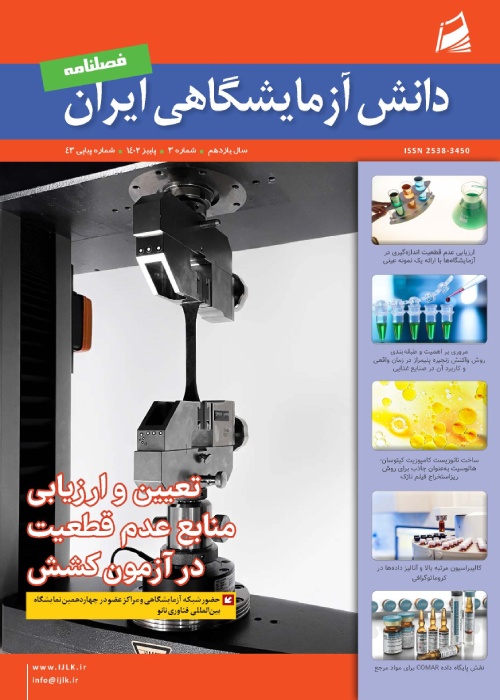فهرست مطالب
مجله دانش آزمایشگاهی ایران
سال هشتم شماره 2 (پیاپی 30، تابستان 1399)
- تاریخ انتشار: 1399/07/03
- تعداد عناوین: 9
- اخبار
- استاندارد
- مقالات
-
صفحات 44-53
-
صفحه 57
-
Pages 5-16
SECM is a powerful method for studying corrosion processes, because it allows simultaneous description of topography and local corrosion activity in the micrometer and sub-micrometer range. A wide ranges of performance modes, with or without redox intermediate, allow for the collection of analytical information and local corrosion processes. This paper presents a brief review of the electrochemical microscopy technique and its applications in the measurement, characterization and evaluation of corrosion systems.
Keywords: Scanning electrochemical microscope, localizedcorrosion, feedback, redox competition, generation-collection, potentiometric, alternatingcurrent -
Pages 17-31
Over the last decades, conventional transmission electron microscope (CTEM) operating under ultra-high vacuum condition is considered essential equipment in the fields like: research, medicine, industrial, etc. although in recent years in order to obtain practical information, researchers have been looking for a solution to observe specimens in a real world conditions (namely: in gaseous and fluidic environments). For this reason, In-situ Environmental Transmission Electron Microscope (In-situ ETEM) is created to achieve the main goal that is viewing various samples in gas or liquid-controlled environment. In this article, ETEM with capability of providing different gas-controlled setups for specimens has been comprehensively discussed. In this kind of microscope, volume around the sample will be filled with gases so that the pressure of the volume is kept higher than that of the TEM column. Therefor ETEM column vacuum will be kept at a constant level and the parts inside it will continue to work under ultra-high vacuum conditions as before. Currently there are two commercial solutions available to observe samples under gaseous environment inside In-situ ETEM, namely differential pumping approach and sealed gas cell. As we will discuss later in this article the sealed gas cell method has various advantages over the latter approach, such as: a much thinner gas path length, a better resolution, a higher pressure limit, much more rapid thermal response, more rapid stabilization of specimen drift, and a much lower cost, etc.
Keywords: In-situ ETEM, Sealed gascell, Differential pumping system(open cell platform), Gas phasereaction, Interaction, Ionization -
Pages 32-36
For many years, oil industry professionals have faced challenges in terms of product quality. These challenges are mixed by the variety of regulations, specifications, and implications for the refining process. Standards developers and officials around the world are seeking more restrictive regulations on the amount of sulfur in various fuels. nowdays many countries set maximum sulfur concentrations in automotive fuels at 5 to 10 parts per million. These strict regulations have increased the need for refineries and manufacturing industries to increase the accuracy of the sulfur analysis method. Using a more accurate method of measuring sulfur, refineries can control their product with higher accuracy and also reduce prices and save their costs. Refineries can avoid misreporting, which lead to regulatory errors and contractual disputes, using a more accurate test method.
Keywords: Total sulfur, reproducibility, renewability, fluorescence, X-ray, ultraviolet, fuel -
Pages 37-43
The microspectrophotometry method, combining microscopic and spectroscopic methods, allows researchers to simultaneously record microscopic images and spectral information from micrometer-sized points Microspectrophotometer used in many applications, including color quality control in flat panel displays, thickness control of printed layers in semiconductor integrated circuits, movement of microfluids, study of biomaterials, study of precious stones and works of art. This tool can also be a very powerful method in forensic laboratories to check the matching of colors in forging documents; Because it analyzes spectral information that reflects the chemical composition of the sample easily, at the moment and point, and does not need sample preparation and destroy the document In order to investigate the forgery of documents, in this research, a microspectrophotometer was used to analyze 7 different aqueous automata. The transmission spectra were performed with two different light sources, one in the visible range of 400 to 700 nm and the other in the ultraviolet to infrared range of 300 to 1100 nm. The results show that by selecting the appropriate spectral range, up to 83% of the difference between different inks can be achieved using this device.
Keywords: Micro Spectrophotometer, Spectroscopy, Ink, Document Forgery -
Pages 44-53
The basic concept of a sample preparation method is to convert a real matrix into a sample in a format that is suitable for analysis. Some gaseous, liquid, and volatile solid samples are suitable for direct injection to gas chromatography instrument. But most samples are not ready to introduce directly into the column of GC. such as removal of serious interferences from the sample, increase of analyte concentration, convert the analyte into a more suitable form to detect and determine, using smaller initial sample sizes and finally achieving higher selectivity. This article discusses various types of analyte extraction, cleanup and concentration. Extraction methods can include classic techniques such as purge and trap, static headspace extraction, and liquid-liquid extraction to newer techniques such as solid phase microextraction, membrane extraction, single drop microextraction and superheated water extraction.
Keywords: Gas chromatography, samplePreparation, solid phase extraction, microextraction, headspace, membrane extraction


